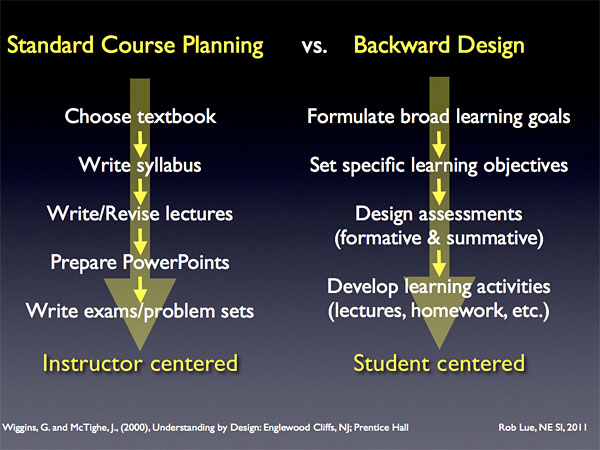Module 6: Backward Design & Open Pedagogy
What is Backward Design | Why Backward Design | Open Pedagogy | Renewable Assignments |Assignment & Discussion
Learning Outcomes:
- Recognize basic principles of backward design
- Understand why to use backward design
- Understand how backward design relates to OER
- Describe open pedagogy and give examples
- Develop “renewable” assignment
What is Backward Design?
Defining Backward Design

Wiggins and McTighe break down backward design into three stages of development: stage one consists of identifying desired results; stage two consists of determining acceptable evidence of meeting results successfully; and, stage three consists of planning learning experiences and instruction based on the previous two stages.
Stage 1: Identify Desired Results
Wiggins and McTighe provide a list of questions which instructors should ask themselves in this stage of design:
-
- What are the course goals/outcomes as deemed by the department and/or the instructor?
What long-term transfer goals are targeted?What meanings should students make to arrive at important understandings?What essential questions will students keep considering?What knowledge and skill will students acquire?What established goals/standards are targeted?
Stage 2: Determine Acceptable Evidence
In stage two, you will ask yourself the following questions:
-
- By what criteria will performance be assessed, in light of Stage 1 desired results?
- What additional evidence will be collected for all Stage 1 desired results?
- Are the assessments aligned to all Stage 1 elements?
This is the stage in which you will decide what type of assignments will best suit your needs as they align with the course goals. Some assignment types and considerations include:
-
- Written assignments: low stakes vs. high stakes, creativity level
- Verbal assignments: speeches, presentations, etc.
- Visual assignments: posters, artworks, videos, etc.
- Service learning and application projects
This is also the stage in which you will decide which assessments are formative and which are summative.
Stage 3: Plan Learning Experience and Instruction
At this point, you are ready to plan the rest of the course, including reading assignments (OER materials) and daily activities. Wiggins and McTighe suggest asking the following questions:
-
- What enabling knowledge (facts, concepts, principles) and skills (processes, procedures, strategies) will students need in order to perform effectively and achieve desired results?
- What activities, experiences, and lessons will lead to achievement of the desired results and success at the assessments?
- How will the learning plan help students achieve transfer, and meaning and acquisition, with increasing independence?
- How will progress be monitored?
- How will the unit be sequenced and differentiated to optimize achievement for all learners?
- Are the learning events in Stage 3 aligned with Stage 1 goals and Stage 2 assessments?
Backward Design Example
Now that you've read about the principles of Backward Design, watch this short video by Open SUNY that applies Backward Design to a real life teaching and learning experience.
Watch Introduction to Backward Design presented by Antonia Jokelova
Attribution
This module was created by Julia Brown. Portions of the content were adapted from:
- City College English Department OER Guide by Yolande Brener, Julia Brown, and Janelle Poe, licensed under CC BY-NC 4.0 International

